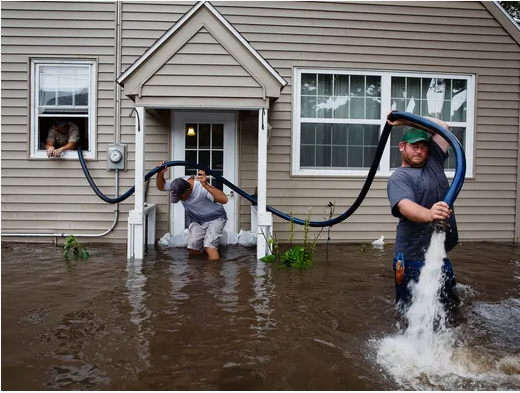Introduction
Water cleanup plays a significant role in preventing water damage, promoting health, and maintaining the integrity of homes, businesses, and ecosystems. From small spill to major flooding, proper water cleanup ensures safety and prevents long term damage. This guide goes through important techniques and steps involved in efficient water restoration.
1. Importance of Immediate Water Cleanup
Cleanup is essential after water damage has occurred to avoid further destruction. Water can penetrate the walls, flooring, and furniture within hours, causing swelling, warping, and growing mold. The sooner the water is removed, the less time it has to destroy your building and possessions and minimize the cost of expensive repairs.
2. Estimation of the Damage
Before initiating the cleaning process of water, it should be evaluated how much damage has been done. It includes the origin of water, whether it is from leakage, floods, or burst pipes, and their most affected areas. The assessment leads one to know what tools would be required for cleaning and if professional assistance is required.
3. Classifications of Water Damage
Water damage is divided into three classes according to the level of contamination:
Clean Water: Typically s from burst pipes or rainwater; safe to touch.
Gray Water: Contaminated but not toxic: includes drainage from bathtubs, washing machines, etc.
Black Water: Heavily contaminated: contamination usually from sewage or floodwaters. This often needs specific cleaning and safety precautions.
4. Safety Precautions When Cleaning
Safety is always primary in water cleanup. Always wear protective gear such as gloves, masks, and waterproof boots when cleaning contaminated water. Switch off electrical circuits for safety in preventing electrical shock. In case the water source is related to sewage, avoid direct contact and seek professional hazardous cleanup.
5. Water Extraction Techniques
Standing water extraction is the first step of cleaning up water. It can be done using pumps, wet vacuums, and water extractors. The method used would usually depend on the volume of water or the area affected. Thorough extraction reduces moisture levels and damage.
6. Drying the Affected Area
Drying is the next major step once the water has been drained. Walls, floors, and furniture must have moisture eliminated promptly to avoid mold growth. Removal of moisture will take less time with fans, dehumidifiers, and specialized drying equipment. Drying should continue until at least 48 hours or until moisture levels get back to normal.
7. Cleaning and Sanitizing Surfaces
Once the area is dry, surfaces should be cleaned and sanitized to get rid of dirt, debris, and any remaining contaminants. In gray or black water, this is extremely vital. Cleaning solutions that kill bacteria and fungi should be used in the area so that health risks and the smells can be reduced.
8. Contending with Mold and Mildew
If moisture is not treated, mold and mildew can begin to grow within 24-48 hours. Look in all areas, particularly hidden areas behind drywall or under flooring, for evidence of mold. Use products that are resistant to mold, and when necessary, hire a professional to remediate the mold.
9. Restoration of Water-Damaged Items
Some must be dealt with special care furniture, electronics, and documents. Furniture can be salvaged by cleaning and drying. Electronics may have to be checked and then repaired. Important documents can be dried and put in frozen for further deterioration. Restoration specialists should be consulted to determine the best restoration techniques for valuable items.
10. How to Prevent Future Water Damage
Once the cleanup is complete, some preventive steps should be taken to avoid future damage caused by water. The first is to check the plumbing systems for leaks, clean the gutters from debris that may prevent water from coming out, and ensure that drainage systems are clear. Waterproofing basements and sealing windows and doors can reduce the possibility of water infiltration.
11. Hiring a Professional Water Cleanup Service
Although some aspects of water cleanup can be done independently, it is well advised to hire a professional restoration company for severe damage. The professionals are equipped with proper equipment and knowledge, and experience on how to execute large-scale water cleanup safely and effectively. They also give a more comprehensive inspection and long-term solutions.
12. Water Cleanup Cost
The cost of water cleanup varies depending on the extent of the damage and the techniques required. Factors such as the size of the affected area, water contamination level, and whether professional services are needed will influence the final cost. Insurance may cover part of the expenses, so it’s important to consult with your insurer.
13. Water Cleanup for Flooded Areas
In the case of flooding, water cleanup is more challenging as a result of the high possibility of contamination and debris. Floodwater contains harmful substances such as sewage and chemicals, and the whole process seems hazardous. This requires specialized equipment and professionals to clean up effectively and safely.
FAQs about Water Cleanup
1. How can I prevent mold growth after water damage? To prevent mold growth, ensure the affected area is thoroughly dried within 24-48 hours. Use dehumidifiers, fans, and ventilation to reduce moisture. If mold is already visible, consider hiring a professional mold remediation service for safe removal.
2. Can I clean up water damage myself, or should I hire a professional? For minor water damage, you may be able to handle the cleanup yourself using proper equipment. However, for large-scale water damage or contamination from sewage or floods, it’s best to hire professionals who can assess the damage and provide a thorough cleanup.
3. Does home insurance cover water damage cleanup? Homeowners’ insurance may cover water damage cleanup, depending on the cause of the damage. It’s essential to check with your insurance provider to understand your coverage and whether you need separate flood insurance.


